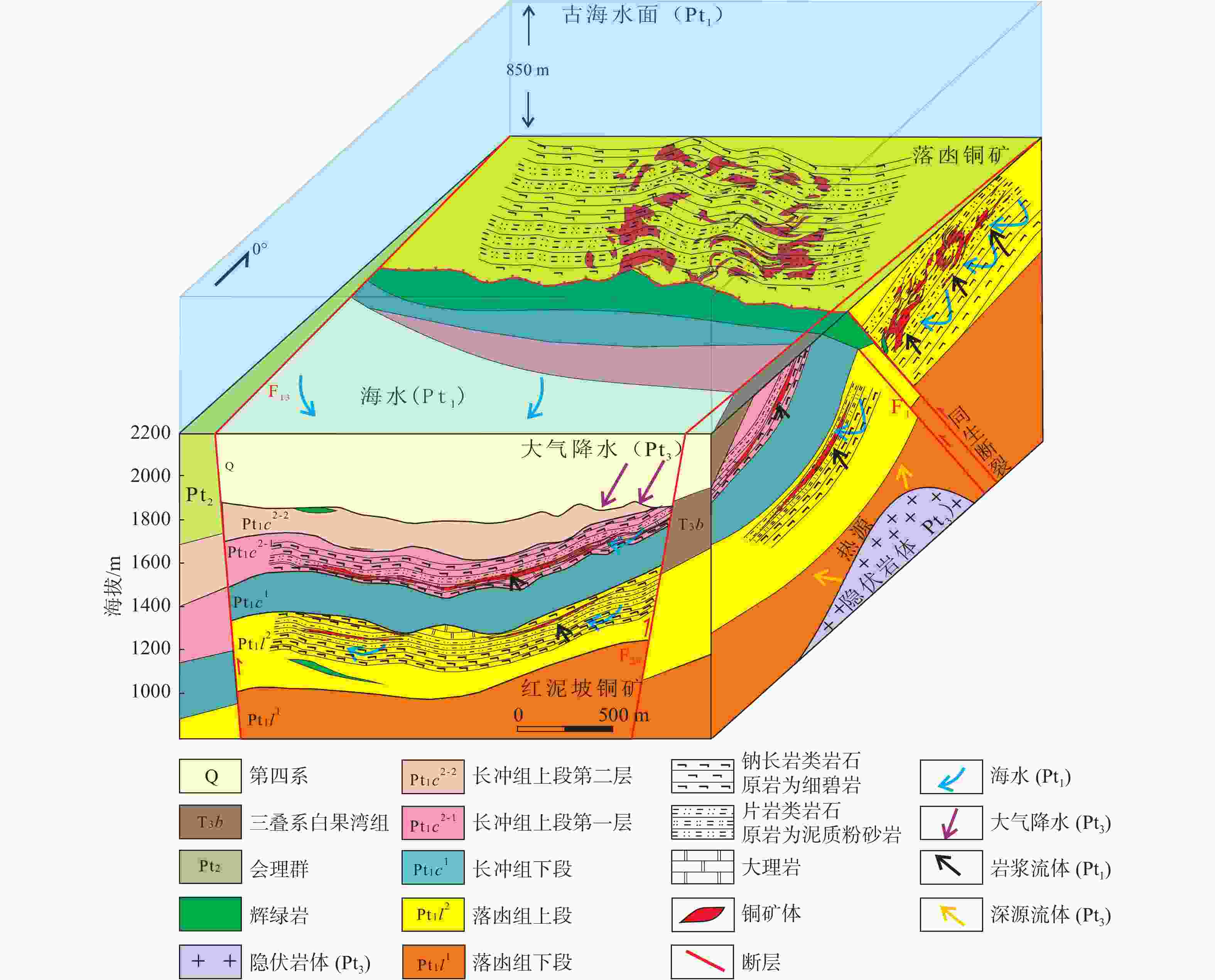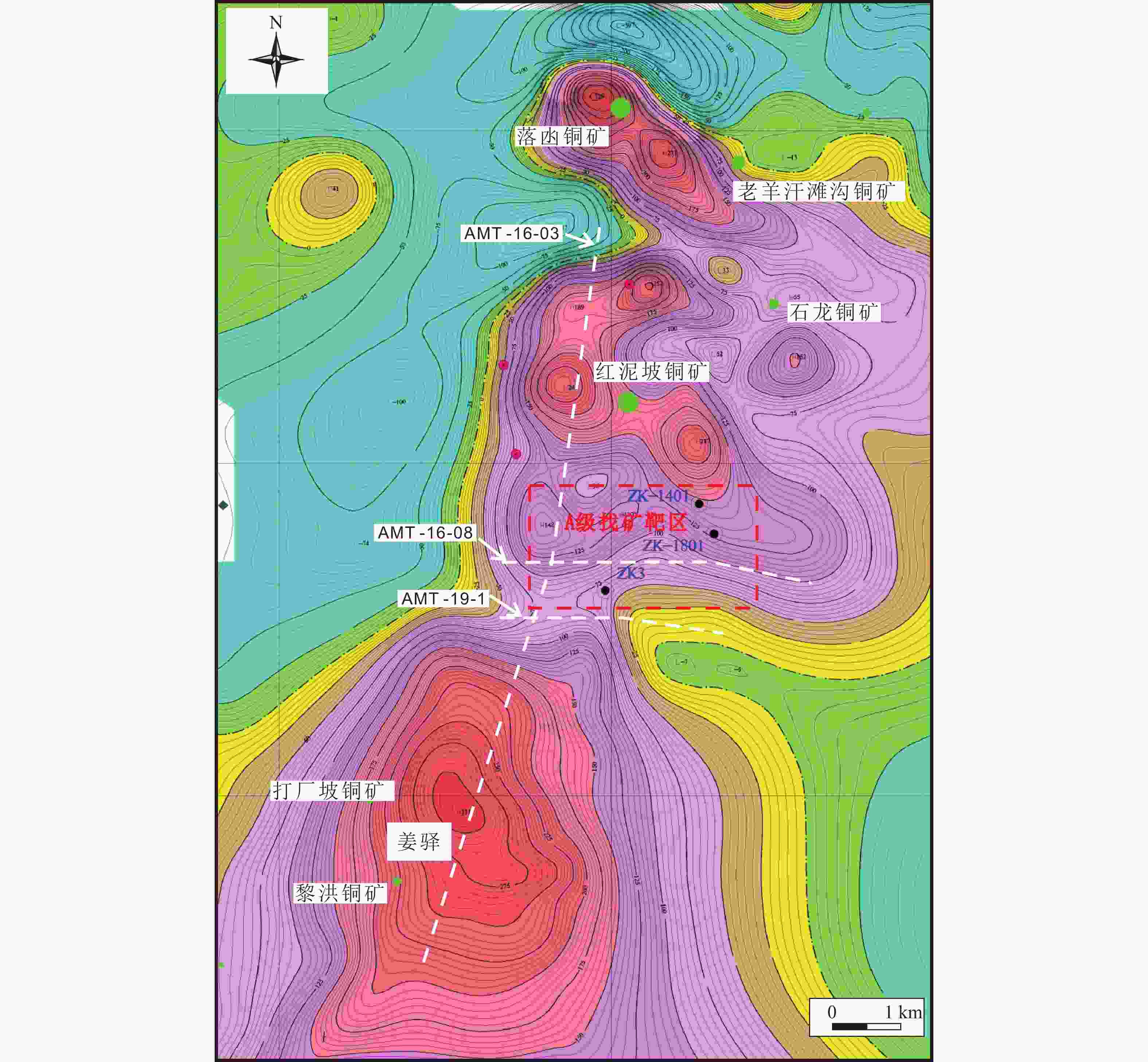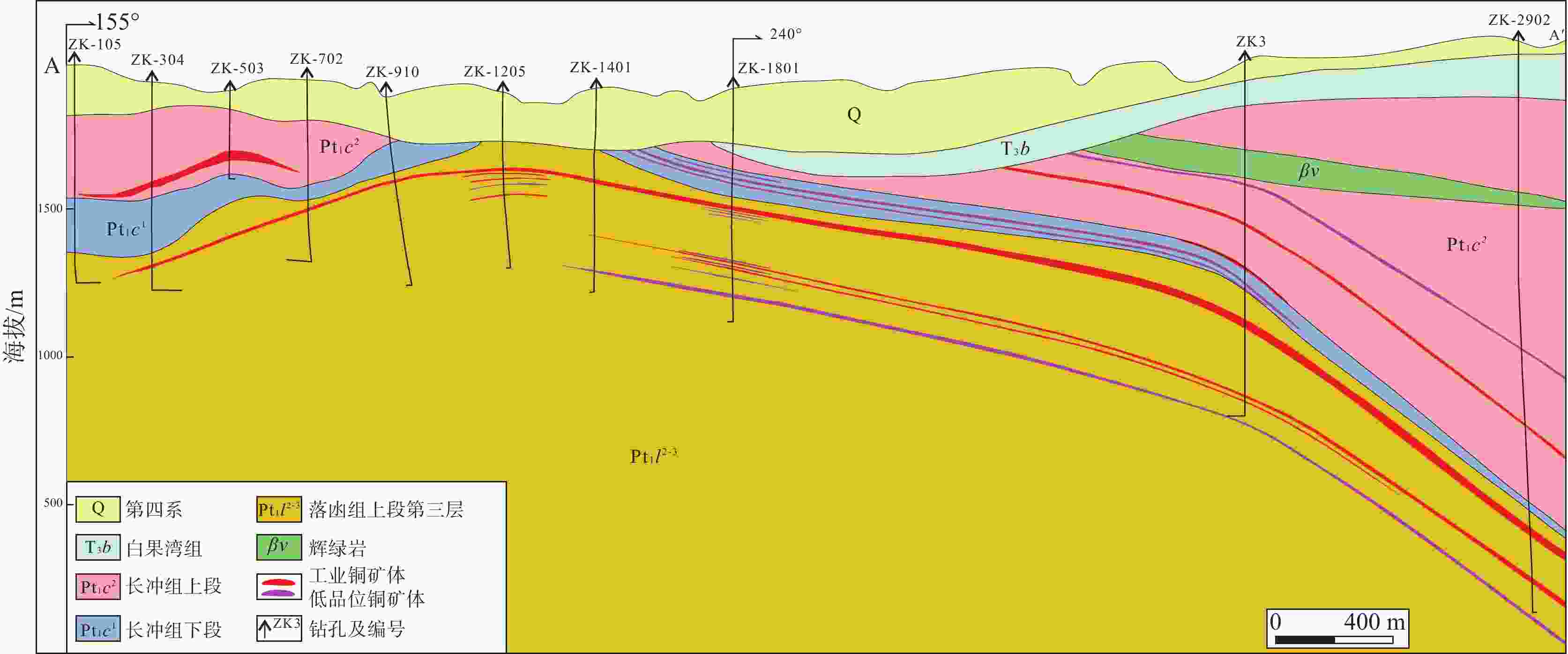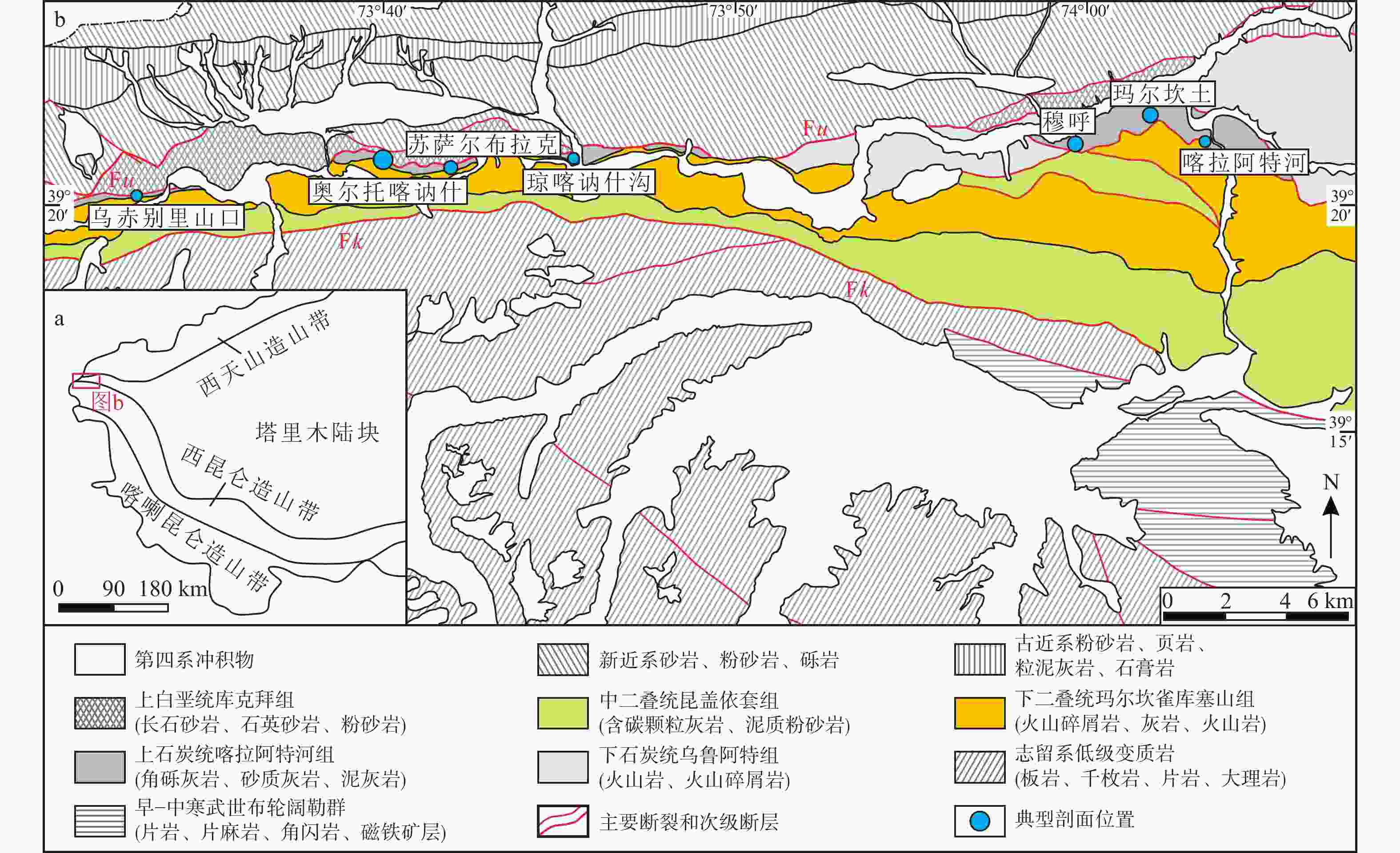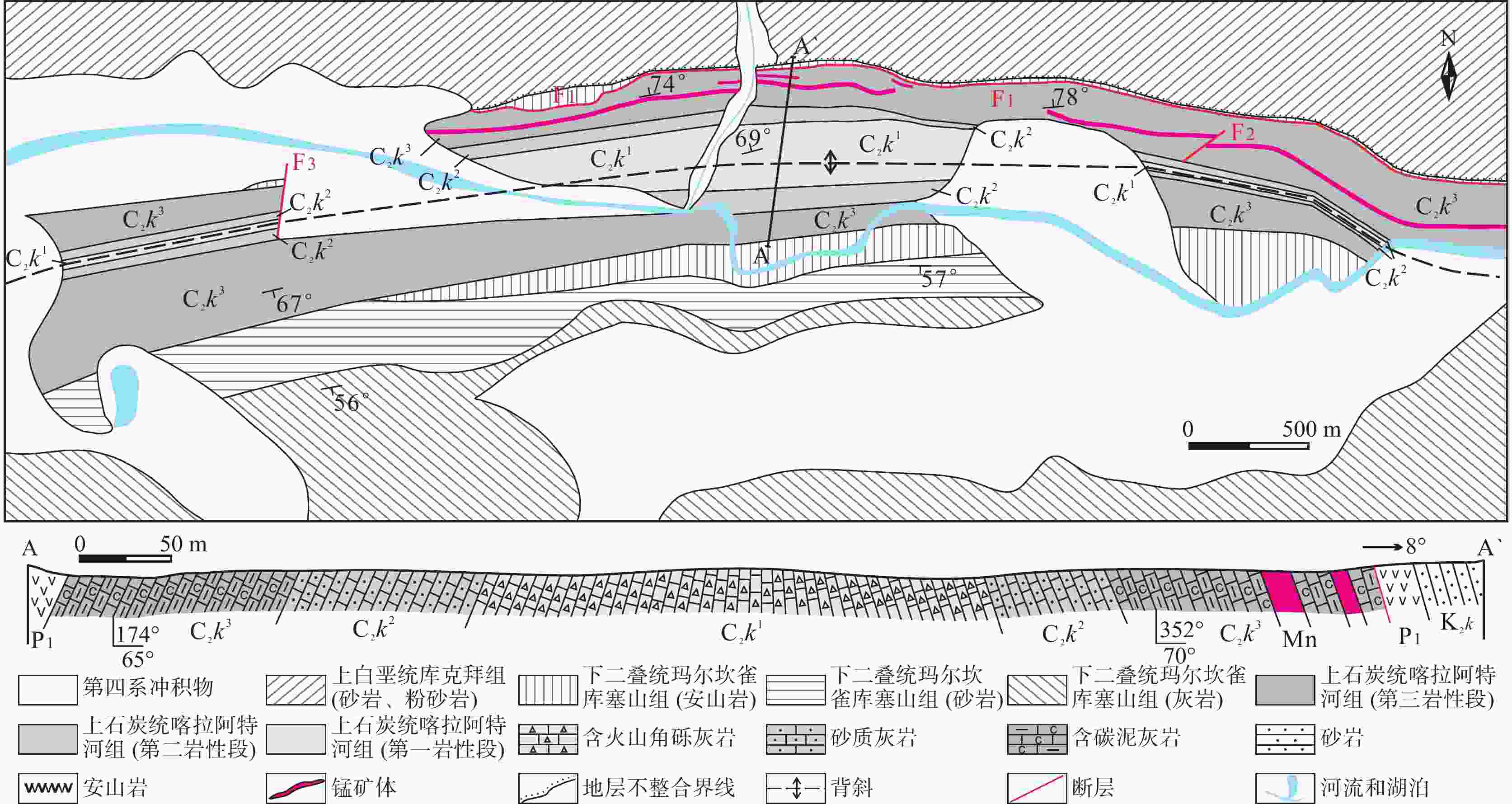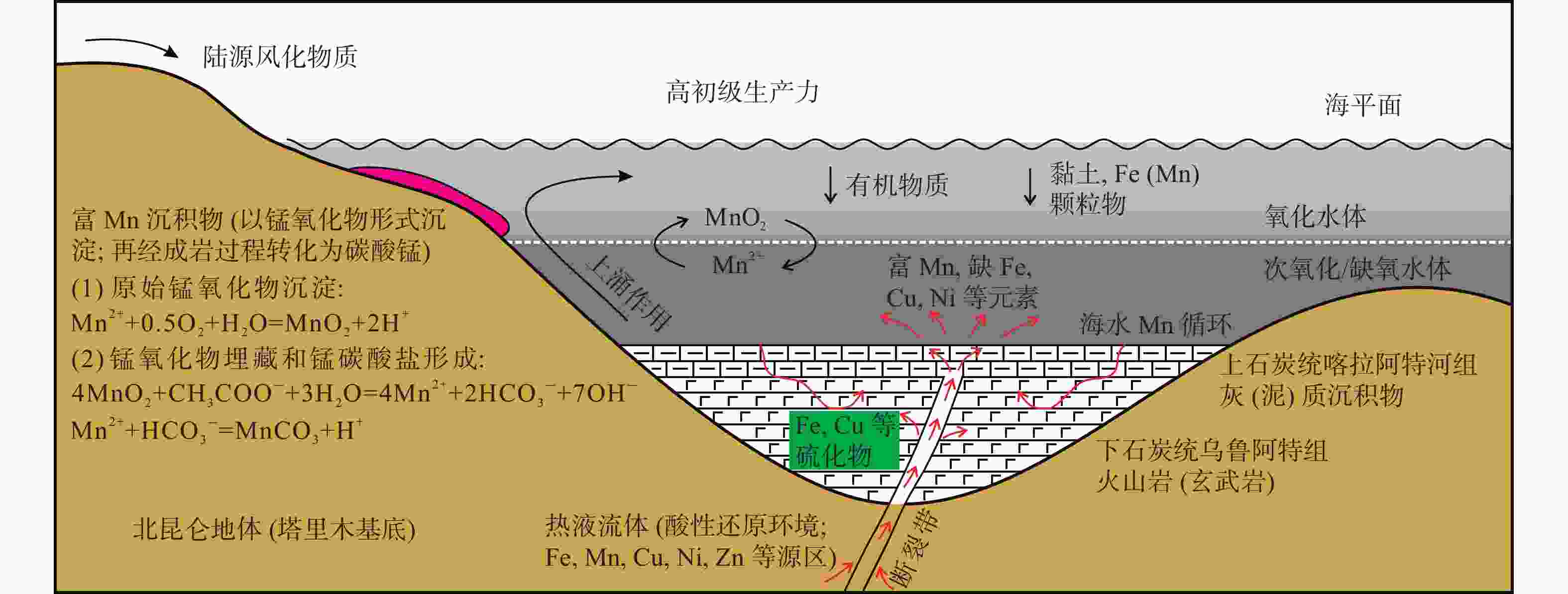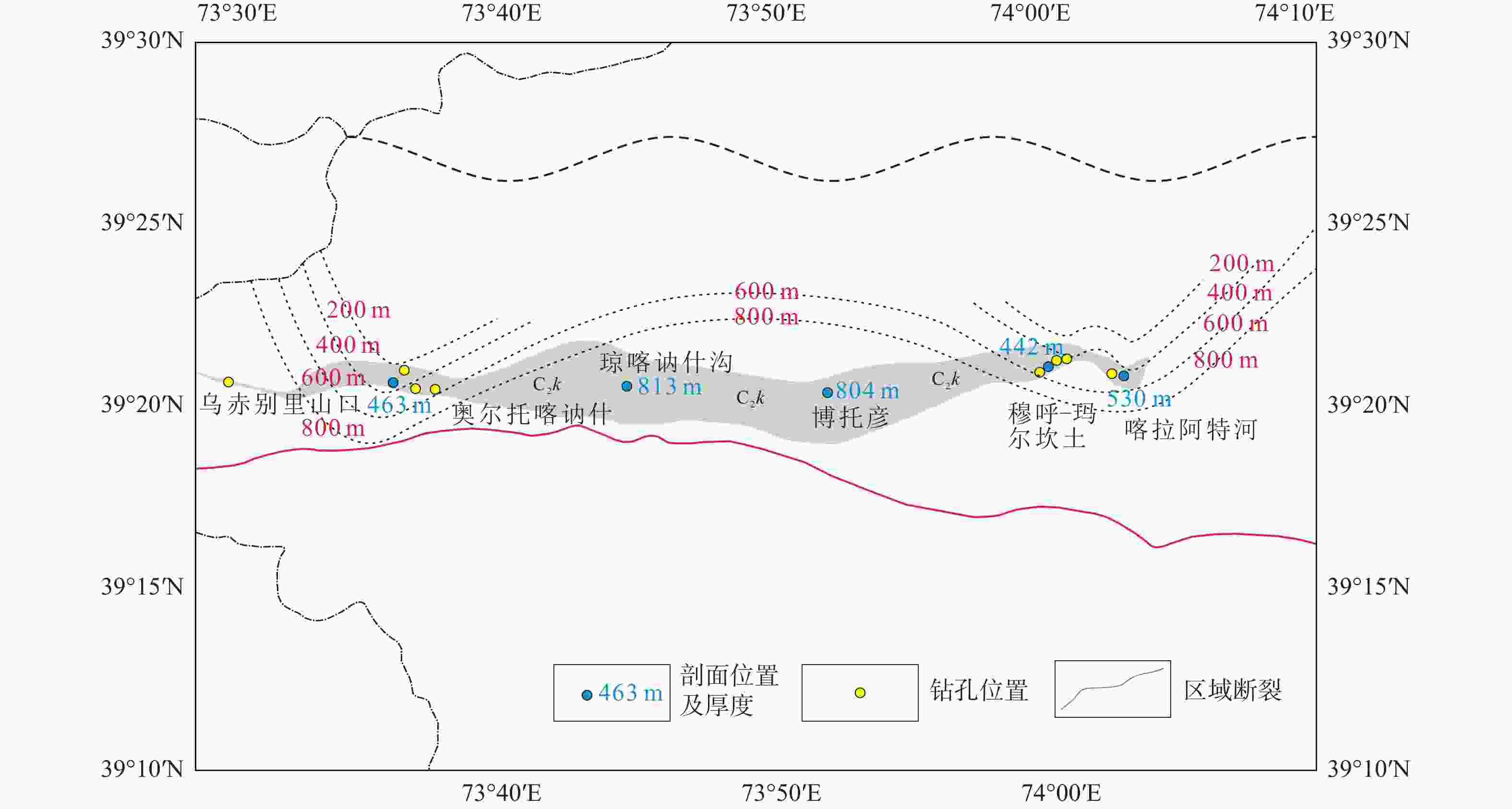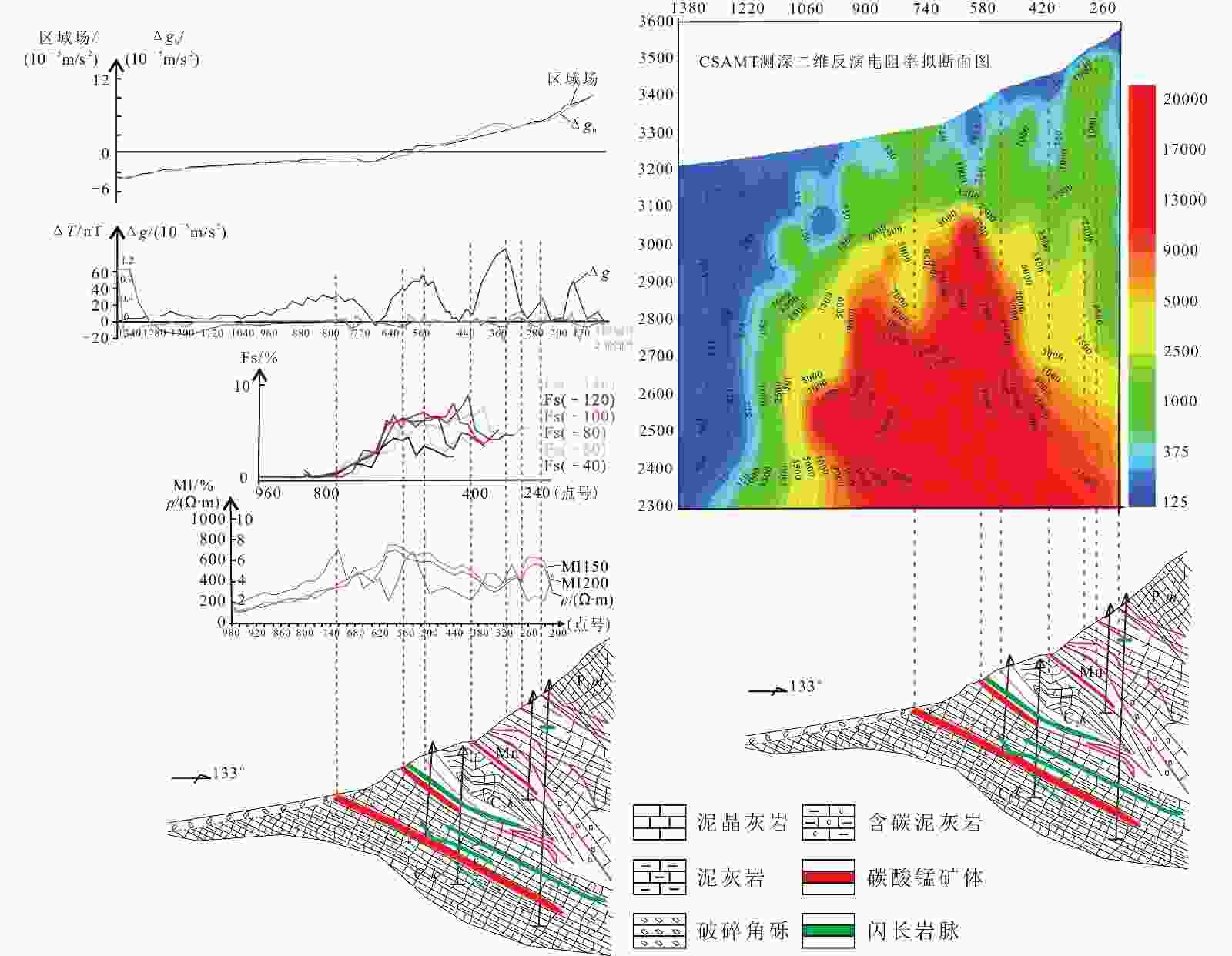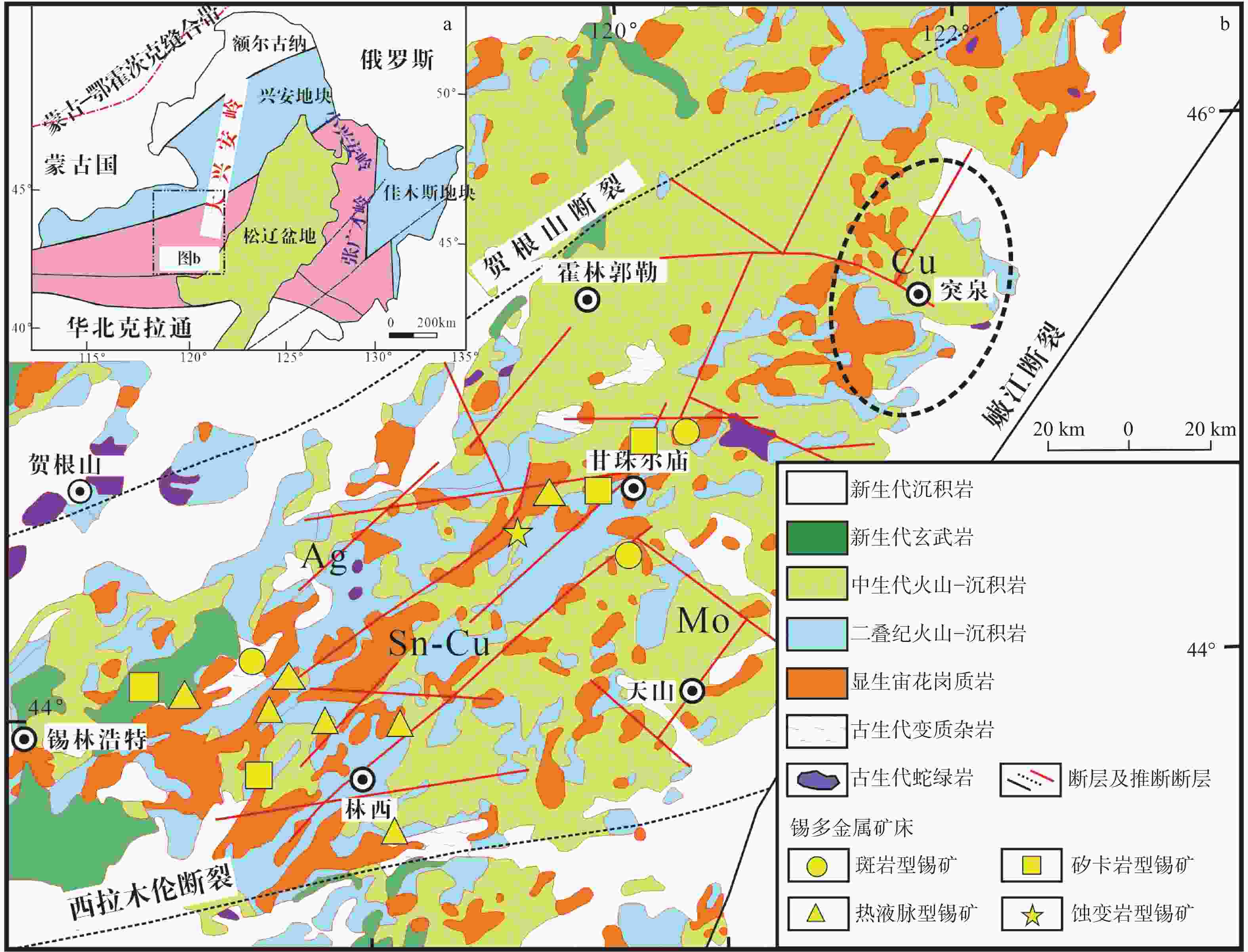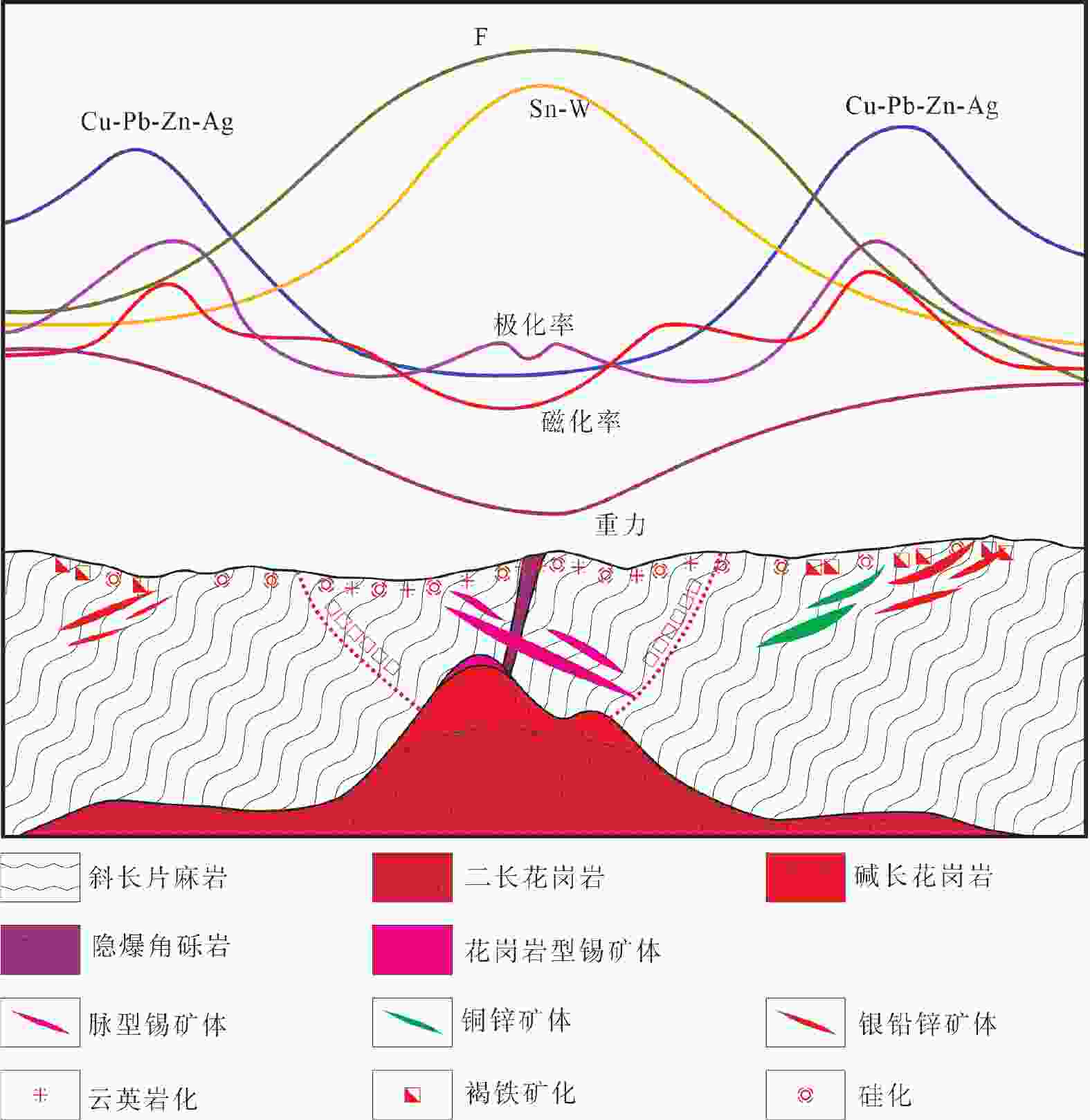The theory and method of ore prospecting prediction for exploration area: Case studies of the Lala copper deposit in Sichuan, Muhu–Maerkantu manganese ore deposit in Xinjiang and Aonaodaba tin-polymetallic deposit in Inner Mongolia
-
摘要: 降低勘查风险、实现科学找矿一直是国内外矿产勘查界不断探索的前缘领域和研究热点,而勘查区找矿预测理论与方法是解决这一难题的有效途径。该方法将成矿作用内因(元素的地球化学特征)和外因(地质作用类型)相结合,构建以成矿地质体、成矿构造与成矿结构面和成矿作用特征标志为主要内容的找矿预测地质模型,通过大比例尺构造蚀变填图、物化探测量和专题研究等综合方法,预测推断矿体赋存位置,最后通过工程施工,发现并查明工业矿体(矿床)。依据勘查区找矿预测理论与方法,在四川拉拉铜矿、新疆玛尔坎苏锰矿带穆呼‒玛尔坎土锰矿及内蒙古大兴安岭南段敖脑达坝地区锡多金属矿开展找矿预测,取得了较好效果。Abstract: Reducing exploration risks and realizing scientific prospecting always have been frontier fields and research hotspots in the world of mineral exploration, the theory and method of ore prospecting prediction for exploration area is the valid channel to deal with this problem. Using this method, a geological model of ore prospecting can be established by combining the internal (geochemical behavior of elements) and external (types of geological processes) control factors for mineralization. The main components of the prospecting prediction model include geological bodies related to mineralization, metallogenetic structure planes and mineralization characteristics. Together with the results of special geological mapping, geophysical and geochemical exploration on large scale, orebodies have been located by synthetic information and explored by drilling. Case studies of the Lala copper deposit in Sichuan, Muhu–Maerkantu manganese ore deposit in Xinjiang and Aonaodaba tin-polymetallic deposit in Inner Mongolia, illustrate the effective application of this method in ore prospecting prediction.
-
图 1 斑岩铜矿找矿预测地质模型(叶天竺等,2014,2017)
Figure 1. Geological model of prospecting prediction for porphyry copper deposits(Ye et al.,2014,2017)
图 2 拉拉地区大地构造位置及矿田地质简图
a—大地构造位置(据Zhou et al.,2014修改);b—矿田地质简图(据陈辉等,2021修改)
Figure 2. Geotectonic position and ore field geological sketch map of the Lala area
(a) Geotectonic position (modified from Zhou et al., 2014); (b) Ore field geological sketch map (modified from Chen et al., 2021)
图 4 拉拉地区局部航磁ΔT平面图(据陈辉等,2021)
Figure 4. Local aeromagnetic ΔT plan map of the Lala area (Chen et al.,2021)
图 6 西昆仑玛尔坎苏大型碳酸锰矿带大地构造简图和地质图
a—西昆仑玛尔坎苏锰矿带大地构造简图(据覃英等,2014修改);b—玛尔坎苏大型碳酸锰矿带地质图(据Zhang et al.,2020修改)
Figure 6. Tectonic sketch and geological map of the giant Malkansu manganese carbonate zone, northwestern portion of the West Kunlun Orogenic Belt (a modified from Qin et al., 2014; b modified from Zhang et al., 2020)
(a)Tectonic sketch; (b) Geological map
图 7 奥尔托喀讷什锰矿床地质图(A−A' 剖面显示矿区背斜构造)(据张帮禄等,2018修改)
Figure 7. Geological map of the Ortokarnash manganese carbonate ore deposit, and the profile A–A' shows the anticline of the mining area (modified from Zhang et al., 2018)
图 8 穆呼–玛尔坎土锰矿床地质图(据董志国等,2020a修改)
Figure 8. Geological map of the Muhu–Maerkantu manganese carbonate ore deposit (modified from Dong et al., 2020a)
图 9 海底热液过程与玛尔坎苏地区锰矿沉积模型(据Zhang et al.,2020修改)
Figure 9. Qualitative model of submarine hydrothermal processes and deposition of the manganese ore deposit in the Malkansu district (modified from Zhang et al, 2020)
图 10 玛尔坎苏锰矿带晚石炭世地层沉积相恢复剖面图(Zhang et al., 2020)
Figure 10. Recovered profile of the late Carboniferous sedimentary facies in the Malkansu manganese zone (Zhang et al., 2020)
图 13 内蒙古黄岗梁–甘珠尔庙成矿带锡矿分布图(据Mi et al.,2020修改)
Figure 13. Locations of the tin polymetallic deposits in the Huanggangliang–Ganzhuermiao metallogenic belt (modified from Mi et al., 2020)
图 14 维拉斯托锡多金属床综合勘查模型(邹滔等,2022)
Figure 14. Prospecting prediction model of the Weilasituo tin polymetallic deposit (Zou et al., 2022)
表 1 主要类型矿床的成矿地质体(叶天竺等,2014)
Table 1. Geological bodies related to the mineralization of the main types of mineral deposits(Ye et al.,2014)
成矿地质作用 矿床类型及主要矿种 成矿地质体 沉积地质作用 沉积型(铁、锰、铜、铀矿) 原型沉积盆地、隐蔽及同生断裂、含矿建造 碎屑岩喷流沉积型(铅锌、铜、铁、锰矿) 含矿层位(以碎屑岩类为主)及成岩同生断裂 砂岩型(铜、铀矿)(这里专指与后生地下水或者其他流体
有关,富含在砂岩中的铜、铀矿)砂岩型铜矿成矿地质体主要为盆地含矿层位及边缘同生断裂;
砂岩型铀矿成矿地质体主要为氧化−还原过渡带砂体碳酸盐岩容矿的非岩浆后生热液型(铅锌矿)(MVT型) 含矿岩层及(深源)断裂构造,或以盆地边缘和后生断裂构造为主 火山地质作用 海相火山喷流沉积型(铜、铅锌矿)(VMS-SEDEX型) 次−火山岩体(深部岩浆来源)、同生−横向断裂(控制喷流口的产出)、
含矿建造(海相火山−沉积地层)陆相次火山岩型(铁矿) 火山机构和次火山岩体 陆相次火山热液型(金、银、铅锌、铜、铀矿) 火山机构中次火山岩体顶部突出小岩株(晚期次火山岩体)等 侵入岩浆地质作用 正岩浆型及伟晶岩型矿床 岩浆房顶部的突出小岩体等 接触交代型(铁、铜、金、铅锌、钨、锡矿) 侵位深度较大的侵入体 高(中)温热液型(钨、锡、稀有、稀土矿) 高F、B的酸性岩浆形成的中深成侵入体(或酸性碱长花岗岩) 斑岩型(铜、钼、金、钨、锡矿) 浅成、超浅成侵入体,少量为次火山岩体 中低温热液型(金、银、铅锌、钼矿) 中浅成岩浆侵入体 远成低温热液型(金、锑、汞、钨矿) 浅成侵入体(浅成脉岩) 区域变质地质作用 受变质型(铁、磷、硼矿) 变质变形构造与含矿地层 大型变形地质作用 韧性剪切带型(金矿) 韧性剪切带中的脆性部位变质建造 表 2 主要成矿构造系统的成矿结构面类型组合及空间格架(叶天竺等,2014)
Table 2. Types and composites of the metallogenetic structural planes in the main metallogenetic systems (Ye et al., 2014)
构造系统 分类 成矿结构面 矿床类型 结构面空间格架 沉积构造系统 陆相 ①盆缘同生断裂面;②岩相界面;③特殊岩性层;④氧化还原界面/转换带;⑤酸碱转换界面;⑥古风化面 风化型 ①+⑥上下结构 砂岩铜、铀矿 ①+②+③+④+⑤上下、左右结构 海相 ①盆缘盆内同生断裂面和横张断裂面;②次级隆拗变换带;③沉降中心部位;④特殊岩性层;⑤岩相带界面;⑥潟湖沙坝;⑦古水温、古水流、古生物变化带;⑧物理化学变换带/面;⑨后生深源断裂;⑩不整合面;⑪古风化面 化学沉积型 ②+③+④+⑤+⑥+⑦+⑧+⑩+⑪+⑨上下、左右结构 同生热水沉积型 ①+④左右结构 后生热液沉积型 ①+④+⑨左右结构 火山构造系统 陆相 ①火山通道;②火山岩性岩相界面;③次火山原生裂隙;④次火山喷发间断面;⑤次火山岩体顶部裂隙带;⑥爆破角砾岩体;⑦叠加区域断裂 次火山热液型 ⑦+③+①+②+⑥+④+⑤上下、左右结构 海相 ①次火山岩体顶部网脉状裂隙带;②火山岩和沉积岩界面;③喷流管道;④叠加区域断裂 火山喷流沉积型 ②+①+③+④上下结构 岩浆侵入构造系统 侵入体 ①岩体底部/侧伏端;②岩体同生边界断裂;③构造岩片;④岩性岩相带 基性、超基性岩浆型 ②+①+④上下结构 地幔岩铬铁矿 ①+③+④上下结构 侵入体接触带 ①叠加区域同生断裂;②岩体接触面;③捕虏体;④岩体顶部网脉状裂隙;⑤岩体外接触带褶曲/“硅钙面” 斑岩型 ①+②+④上下结构 接触交代型 ①+③+①+⑤左右结构 中高温热液型 ①+②+④上下结构 中低温热液型 ①+②上下结构 褶皱构造系统 褶曲、同生断裂 ①向形构造轴部;②背斜转折端/轴部 沉积变质型 ① ①褶皱同生断裂;②背斜褶曲层间破碎带 接触交代型、
中低温热液型①+②左右、上下结构 断裂构造系统 剪切带 ①韧性剪切带脆性叠加部位 韧性剪切带型 ①上下结构 ①脆性断裂侧伏;②叠加于一切成岩原生构造 中低温热液型 ①+②上下结构 断裂系统 ①层间破碎带;②沉积不整合界面 卡林型金矿 ①+②上下结构 -
CHEN D H, SUI Q L, ZHAO X J, et al. , 2019. Geology, geochemical characteristics, and sedimentary environment of Mn-bearing carbonate from theLate Carboniferous Muhu manganese deposit in West Kunlun[J]. Acta SedimentologicaSinica, 37(3): 477-490. (in Chinese with English abstract) CHEN D H, SUI Q L, GUO Z P, et al. , 2022. Sedimentary environment of Mn-bearing carbonate from the Muhu manganese deposit in Malkansu, West Kunlun: Evidences from Fusulinids and C-O-Sr isotopes[J]. Northwestern Geology, 55(2): 1-13. (in Chinese with English abstract) CHEN G W, 1991. The characteristic and paragneiss of the spilite-keratophyre formation from Hekou group in Huili, Sichuan Province[J]. Acta Geologica Sichuan, 11(4): 255-261. (in Chinese) CHEN G W, CHENG D R, YU X W, 1992. The typomorphic feature of pyrite in the copper deposit of LARLAR, Sichuan Province[J]. Mineralogy and Petrology, 12(3): 85-91. (in Chinese with English abstract) CHEN G W, XIA B, 2001. Study on the genesis of Lala copper deposit, Sichuan Province[J]. Bulletin of Mineralogy, Petrology and Geochemistry, 20(1): 42-44. (in Chinese with English abstract) CHEN H, LIN L J, PANG Z S, et al. , 2021. Construction and demonstration of an ore prospecting model for the Lala copper deposit in Huili, Sichuan[J]. Earth Science Frontiers, 28(3): 309-327. (in Chinese with English abstract) CHEN J P, LÜ P, WU W, et al. , 2007. A 3D method for predicting blind orebodies, based on a 3D visualization model and its application[J]. Earth Science Frontiers, 14(5): 54-62. (in Chinese with English abstract) doi: 10.1016/S1872-5791(07)60035-9 CHEN J P, LI J, CUI N, et al. , 2015. The construction and application of geological cloud under the big data background[J]. Geological Bulletin of China, 34(7): 1260-1265. (in Chinese with English abstract) CHEN W, ZHAO X F, LI X C, et al. , 2019. An overview on the characteristics and origin of iron-oxide copper gold (IOCG) deposits in China[J]. Acta Petrologica Sinica, 35(1): 99-118. (in Chinese with English abstract) doi: 10.18654/1000-0569/2019.01.07 CHEN W T, ZHOU M F, 2012. Paragenesis, stable isotopes, and molybdenite Re-Os isotope age of the Lala iron-copper deposit, Southwest China[J]. Economic Geology, 107(3): 459-480. doi: 10.2113/econgeo.107.3.459 CHEN W T, ZHOU M F, ZHAO X F, 2013. Late Paleoproterozoic sedimentary and mafic rocks in the Hekou area, SW China: implication for the reconstruction of the Yangtze Block in Columbia[J]. Precambrian Research, 231: 61-77. doi: 10.1016/j.precamres.2013.03.011 CHEN W T, ZHOU M F, LI X C, et al. , 2019. In situ Pb-Pb isotopic dating of sulfides from hydrothermal deposits: a case study of the Lala Fe-Cu deposit, SW China[J]. Mineralium Deposita, 54(5): 671-682. doi: 10.1007/s00126-018-0833-1 CHEN Y C, PEI R F, WANG D H, 2006. On Minerogenetic(Metallogenetic)series: Third discussion[J]. Acta Geologica Sinica, 80(10): 1501-1508. (in Chinese with English abstract) CHEN Y Q, CHEN Y C, ZHAO Y M, et al. , 1983. Further discussion on the problems of minerogenetic series of mineral deposits[J]. Bulletin Chinese Acad. Geol. Sci. (6): 1-64. (in Chinese with English abstract) CRERAR D A, NAMSON J, CHYI M S, et al. , 1982. Manganiferous cherts of the Franciscan assemblage: I. General geology, ancient and modern analogues, and implications for hydrothermal convection at oceanic spreading centers[J]. Economic Geology, 77(3): 519-540. doi: 10.2113/gsecongeo.77.3.519 DONG X Z, YANG H, FAN J H, et al. , 2019. Research on sulfur isotopes and metallogenic physicochemical conditions of Weilasituo Zn-Cu-Ag deposit, Inner Mongolia[J]. Global Geology, 38 (4): 953-961. (in Chinese with English abstract) DONG Z G, ZHANG L C, DONG F Y, et al. , 2020a. Geological characteristics, ore-controlling factors and metallogenic model of Muhu manganese deposit in West Kunlun, China[J]. Journal of Jilin University (Earth Science Edition), 50(5): 1358-1372. (in Chinese with English abstract) DONG Z G, ZHANG L C, WANG C L, et al. , 2020b. Progress and problems in understanding sedimentary manganese carbonate metallogenesis[J]. Mineral Deposits, 39(2): 237-255. (in Chinese with English abstract) FAN Y X, YANG Z X, 2003. Metallogenetic regularities and prediction[M]. Xuzhou: China University of Mining and Technology Press. (in Chinese) FANG W X, 2012. Types of geochemical lithofacies and their applications in basin[J]. Geoscience, 26(5): 996-1007. (in Chinese with English abstract) FANG W X, 2014. Geotectonic evolution and the Proterozoic iron oxide copper-gold deposits on the western margin of the Yangtze massif[J]. Geotectonica et Metallogenia, 38(4): 733-757. (in Chinese with English abstract) GAO X, ZHOU Z H, BREITER K, et al. , 2019. Ore-formation mechanism of the Weilasituo tin-polymetallic deposit, NE China: Constraints from bulk-rock and mica chemistry, He-Ar isotopes, and Re-Os dating[J]. Ore Geology Reviews, 109: 163-183. doi: 10.1016/j.oregeorev.2019.04.007 GAO Y B, TENG J X, CHEN D H, et al. , 2016. Geology, geochemistry and genesis of the Orto Karnash manganese ore deposit[J]. Mineral Deposits, 35(S1): 5-6. (in Chinese) GAO Y B, TENG J X, LI W Y, et al. , 2018. Geology, geochemistry and ore genesis of the Aoertuokanashi manganese deposit, western Kunlun, Xinjiang, Northwest China[J]. Acta PetrologicaSinica, 34(8): 2341-2358. (in Chinese with English abstract) GENG Y S, KUANG H W, DU L L, et al. , 2019. On the Paleo-Mesoproterozoic boundary from the breakup event of the Columbia supercontinent[J]. Acta Petrologica Sinica, 35(8): 2299-2324. (in Chinese with English abstract) doi: 10.18654/1000-0569/2019.08.02 GREENTREE M R, 2007. Tectonostratigraphic analysis of the Proterozoic Kangdian Iron Oxide-Copper province, South-west China[D]. Perth: The University of Western Australia. GREENTREE M R, LI Z X, 2008. The oldest known rocks in south-western China: SHRIMP U-Pb magmatic crystallisation age and detrital provenance analysis of the Paleoproterozoic Dahongshan Group[J]. Journal of Asian Earth Sciences, 33(5-6): 289-302. doi: 10.1016/j.jseaes.2008.01.001 HAN R S, 2003. Preliminary discussion on research contents and methods of tectono-metallogenic dynamics and concealed ore orientation prognosis[J]. Geology and Prospecting, 39(1): 5-9. (in Chinese with English abstract) HAN R S, 2005. Orefield/deposit tectono-geochemical method for the localization and prognosis of concealed orebodies[J]. Geological Bulletin of China, 24(10-11): 978-984. (in Chinese with English abstract) HU H M, ZHAO P D, LI Z J, 1995. Large scale mineral prediction method[M]. Beijing: Geological Press. (in Chinese) HUANG C K, BAI Y, ZHU Y S, et al., 2001. The copper deposits in China[M]. Beijing: Geological Press. (in Chinese) JIANG S H, ZHNG L L, LIU Y F, et al. , 2018. Metallogeny of Xing-Meng Orogenic Belt and some related problems[J]. Mineral Deposits, 37(4): 671-711. (in Chinese with English abstract) JIN C, XIE Y Q, LI Y F, et al. , 2021. Palaeogeographic reconstruction for the Mn-bearing Formation in the Malkansu manganese deposit belt[J]. Xinjiang Nonferrous Metal, 44(1): 26-27. (in Chinese) JIN M X, SHEN S, 1998. Fluid features and metallogenic conditions in LALA copper deposit, Huili, Sichuan, China[J]. Geological Science and Technology Information, 17(S1): 45-48. (in Chinese with English abstract) LI W J, PENG Z D, DONG Z G, et al. , 2022. Direct Re-Os dating of manganese carbonate ores and implications for the formation of the Ortokarnash manganese deposit, Northwest China[J]. Economic Geology, 117(1): 237-252. doi: 10.5382/econgeo.4865 LI Z Q, WANG J Z, LIU J J, et al. , 2003. Re-Os dating of molybdenite from LALA Fe-Oxide-Cu-Au-Mo-REE deposit, southwest China: Implications for ore genesis[J]. Contributions to Geology and Mineral Resources Research, 18(1): 39-42. (in Chinese with English abstract) LIU R L, WU G, LI T G, et al. , 2018. LA-ICP-MS cassiterite and zircon U-Pb ages of the Weilasituo tin-polymetallic deposit in the southern Great Xing’an Range and their geological significance[J]. Earth Science Frontiers, 25(5): 183-201. (in Chinese with English abstract) LIU Y F, JIANG S H, BAGAS L, 2016. The genesis of metal zonation in the Weilasituo and Bairendaba Ag-Zn-Pb-Cu-(Sn-W) deposits in the shallow part of a porphyry Sn-W-Rb system, Inner Mongolia, China[J]. Ore Geology Reviews, 75: 150-173. doi: 10.1016/j.oregeorev.2015.12.006 MAO J W, ZHANG Z H, PEI R F, 2012. An introduction of mineral deposits models in China[M]. Beijing: Geological Press. (in Chinese) MAYNARD J B, 2010. The chemistry of manganese ores through time: a signal of increasing diversity of earth-surface environments[J]. Economic Geology, 105(3): 535-552. doi: 10.2113/gsecongeo.105.3.535 MEI W, LÜ X B, TANG R K, et al. , 2015. Ore-forming fluid and its evolution of Bairendaba-Weilasituo deposits in west slope of southern Great Xing’an Range[J]. Earth Science-Journal of China University of Geosciences, 40(1): 145-162. (in Chinese with English abstract) doi: 10.3799/dqkx.2015.010 MI K F, LÜ Z C, YAN T J, et al. , 2020. Zircon geochronological and geochemical study of the Baogaigou Tin deposits, southern Great Xing'an Range, Northeast China: Implications for the timing of mineralization and ore genesis[J]. Geological Journal, 55(7): 5062-5081. doi: 10.1002/gj.3729 MU S L, 2016. Volcanic rocks tectonic environments and metallogenesis of typical mineral deposits in Kungai Mountains, West Kunlun[D]. Guangzhou: Guangzhou Institute of Geochemistry, Chinese Academy of Sciences, 1-186. (in Chinese with English abstract) OUYANG H G, MAO J W, SANTOSH M, et al. , 2014. The Early Cretaceous Weilasituo Zn-Cu-Ag vein deposit in the southern Great Xing'an Range, northeast China: Fluid inclusions, H, O, S, Pb isotope geochemistry and genetic implications[J]. Ore Geology Reviews, 56: 503-515. doi: 10.1016/j.oregeorev.2013.06.015 OUYANG H G, MAO J W, ZHOU Z H, et al. , 2015. Late Mesozoic metallogeny and intracontinental magmatism, southern Great Xing'an Range, northeastern China[J]. Gondwana Research, 27(3): 1153-1172. doi: 10.1016/j.gr.2014.08.010 QIN Y, WEN G G, LI D P, 2014. Geological and geochemical characteristics of high-grade manganese ore deposit in Aketao County, west Kunlun, Xinjiang Province, and its prospecting significance[J]. Western Prospecting Project, 26(8): 112-115. (in Chinese) QIU L, ZHOU J, LIU X W, et al. , 2016. Application of integrated geophysical methods to M163-1 aeromagnetic anomaly inspection of Lala, Huili, Sichuan province[J]. Computing Techniques for Geophysical and Geochemical Exploration, 38(5): 603-609. (in Chinese with English abstract) QUAN H Y, CAI W Y, ZHANG X B, et al. , 2017. Characteristics of fluid inclusions and genesis of Weilasituo Pb-Zn deposit, Inner Mongolia[J]. Global Geology, 36(1): 105-117. (in Chinese with English abstract) ROMER R L, KRONER U, 2016. Phanerozoic tin and tungsten mineralization: Tectonic controls on the distribution of enriched protoliths and heat sources for crustal melting[J]. Gondwana Research, 31: 60-95. doi: 10.1016/j.gr.2015.11.002 SHENTU B Y, 1997. Geological and geochemical characteristics and metallogenic model forthe Lalachang copper deposit inHuili, Sichuan[J]. Tethyan Geology(21): 112-126. (in Chinese with English abstract) SINGER D A, MENZIE W D, 2010. Quantitative mineral resource assessments: An integrated approach[M]. Oxford: Oxford University Press. SUN J Y, YU W J, TANG Z X, et al. , 2019. Discovery of the ore-bearing mafic layered sill in the Lala Fe-Cu ore district, western Sichuan province, China and its implications for petrogenesis and metallogenesis[J]. Earth Science Frontiers, 26(1): 313-325. (in Chinese with English abstract) TANG L, LIU J J, ZHU X Y, et al. , 2017. Geochemical characteristics and geological implication of Kuijiashan granite pluton, Inner Mongolia[J]. Mineral Exploration, 8(6): 1031-1043. (in Chinese with English abstract) VAN CAPPELLEN P, WANG Y F, 1996. Cycling of iron and manganese in surface sediments: a general theory for the coupled transport and reaction of carbon, oxygen, nitrogen, sulfur, iron, and manganese[J]. American Journal of Science, 296(3): 197-243. doi: 10.2475/ajs.296.3.197 WANG F X, BAGAS L, JIANG S H, et al. , 2017. Geological, geochemical, and geochronological characteristics of Weilasituo Sn-polymetal deposit, Inner Mongolia, China[J]. Ore Geology Reviews, 80: 1206-1229. doi: 10.1016/j.oregeorev.2016.09.021 WANG G W, ZHANG Z Q, LI R X, et al. , 2021. Resource prediction and assessment based on 3D/4D big data modeling and deep integration in key ore districts of North China[J]. Science China Earth Sciences, 64(9): 1590-1606. doi: 10.1007/s11430-020-9791-4 WANG S C, 2010. The new development of theory and method of synthetic information mineral resources prognosis[J]. Geological Bulletin of China, 29(10): 1399-1403. (in Chinese with English abstract) WHITE N C, HEDENQUIST J W, 1995. Epithermal gold deposits: styles, characteristics and exploration[J]. SEG Newsletter(23): 1-9. XIAO K Y, ZHANG X H, WANG S L, et al. , 2000a. GIS assessment system of mineral resources[M]. Beijing: Geological Press. (in Chinese) XIAO K Y, ZHU Y S, SONG G Y, 2000b. GIS quantitative assessment and prospecting of mineral resources[J]. Geology in China(7): 29-32. (in Chinese) XIAO K Y, DING J H, LIU R, 2006. The discussion of three-part form of non-fuel mineral resource assessment[J]. Geological Review, 52(6): 793-798. (in Chinese with English abstract) XIAO K Y, LI N, SUN L, et al. , 2012. Large scale 3D mineral prediction methods and channels based on 3D information technology[J]. Journal of Geology, 36(3): 229-236. (in Chinese with English abstract) XIAO K Y, SUN L, LI N, et al. , 2015. Mineral resources assessment under the thought of big data[J]. Geological Bulletin of China, 34(7): 1266-1272. (in Chinese with English abstract) YE T Z, 2013. Theoretical framework of methodology of deposit modeling and integrated geological information for mineral resource potential assessment[J]. Journal of Jilin University (Earth Science Edition), 43(4): 1053-1072. (in Chinese with English abstract) YE T Z, LÜ Z C, PANG Z S, et al. , 2014. Introduction of Prospecting prediction theory and method in exploration area[M]. Beijing: Geological Press. (in Chinese) YE T Z, WEI C S, WANG Y W, et al. , 2017. Inclusion of Prospecting prediction theory and method in exploration area[M]. Beijing: Geological Press. (in Chinese) YU P P, CHEN J P, CHAI F S, et al. , 2015. Research on model-driven quantitative prediction and evaluation of mineral resources based on geological big data concept[J]. Geological Bulletin of China, 34(7): 1333-1343. (in Chinese with English abstract) YU X F, LÜ Z C, SUN H R, et al. , 2020. Metallogenic system of integrated exploration area and new exploration progress[J]. Journal of Jilin University (Earth Science Edition), 50(5): 1261-1288. (in Chinese with English abstract) ZHAI M G, HU B, 2021. Thinking to state security, international competition and national strategy of mineral resources[J]. Journal of Earth Sciences and Environment, 43(1): 1-11. (in Chinese with English abstract) ZHAI Y S, 2000. Metallogenic system and its evolution: From preliminary practice to theoretical consideration[J]. Earth Science-Journal of China University of Geosciences, 25(4): 333-339. (in Chinese with English abstract) ZHAI Y S, 2003a. Research on metallogenic system[J]. Geological Survey and Research, 26(2): 65-71. (in Chinese with English abstract) ZHAI Y S, 2003b. Research on metallogenic system[J]. Geological Survey and Research, 26(3): 129-135. (in Chinese with English abstract) ZHAI Y S, DENG J, PENG R M, et al. , 2010. Metallogenic system[M]. Beijing: Geological Press. (in Chinese) ZHANG B L, ZHANG L C, FENG J, et al. , 2018. Genesis of the large-scale Orto Karnash manganese carbonate deposit in the Malkansu District, western Kunlun: Evidence from geological features[J]. Geological Review, 64(2): 361-377. (in Chinese with English abstract) ZHANG B L, WANG C L, ROBBINS L J, et al. , 2020. Petrography and geochemistry of the Carboniferous Ortokarnash manganese deposit in the western Kunlun mountains, Xinjiang Province, China: Implications for the depositional environment and the origin of mineralization[J]. Economic Geology, 115(7): 1559-1588. doi: 10.5382/econgeo.4729 ZHANG H, 2009. Study on geological features and ore genesis of Aktash and Saluoyi VMS deposits, West Kunlun[D]. Jilin: Jilin University, 1-74. (in Chinese with English abstract) ZHANG L C, ZHANG B L, DONG Z G, et al. , 2020. Tectonic setting and metallogenetic conditions of Carboniferous Malkansu giant manganese belt in west Kunlun orogen[J]. Journal of Jilin University (Earth Science Edition), 50(5): 1340-1357. (in Chinese with English abstract) ZHANG S H, LIN Z Y, 2021. Technological and methodological changes of (uranium) mineral resources prediction in big data era[J]. Uranium Geology, 37(5): 913-919. (in Chinese with English abstract) ZHAO P D, HU W L, LI Z J, 1983. The theory and practices of statistical prediction for mineral deposits[J]. Earth Science-Journal of China University of Geosciences, 8(4): 107-121. (in Chinese with English abstract) ZHAO P D, CHI S D, 1991. A preliminary view on geological anomaly[J]. Earth Science-Journal of China University of Geosciences, 16(3): 241-248. (in Chinese with English abstract) ZHAO P D, LI Z J, HU G D, 1992. Statistical prediction of three-dimensional deposits in key metallogenic areas: a case study in the Yueshan district[M]. Wuhan: China University of Geosciences Press. (in Chinese) ZHAO P D, MENG X G, 1993. Geological anomaly and mineral prediction[J]. Earth Science-Journal of China University of Geosciences, 18(1): 39-47. (in Chinese with English abstract) ZHAO P D, HU W L, LI Z J, 1994. Statistical prediction of mineral deposits[M]. 2nd ed. Beijing: Geological Press. (in Chinese) ZHAO P D, WANG J G, RAO M H, et al. , 1995. Geologic anomaly of China[J]. Earth Science-Journal of China University of Geosciences, 20(2): 117-127. (in Chinese with English abstract) ZHAO P D, CHI S D, CHEN Y Q, 1996. A thorough investigation of geo-anomaly: A basis of metallogenic prognosis[J]. Geological Journal of China Universities, 2(4): 361-373. (in Chinese with English abstract) ZHAO P D, CHEN Y Q, 1998. The main way of geo-anomaly location of ore body[J]. Earth Science-Journal of China University of Geosciences, 23(2): 111-114. (in Chinese with English abstract) ZHAO P D, 2000. “Three Components” quantitative mineral prediction[M]. Beijing: China University of Geosciences Press. (in Chinese) ZHAO P D, CHEN J P, CHEN J G, 2001. On diversity of mineralization and the spectrum of ore deposits[J]. Earth Science-Journal of China University of Geosciences, 26(2): 111-117. (in Chinese with English abstract) ZHAO P D, 2002. “Three-Component” quantitative resource prediction and assessments: theory and practice of digital mineral prospecting[J]. Earth Science-Journal of China University of Geosciences, 27(5): 482-489. (in Chinese with English abstract) ZHAO P D, CHEN J P, ZHANG S T, 2003. The new development of“Three Components”quantitative mineral prediction[J]. Earth Science Frontiers, 10(2): 455-463. (in Chinese with English abstract) ZHAO P D, 2007. Quantitative mineral prediction and deep mineral exploration[J]. Earth Science Frontiers, 14(5): 1-10. (in Chinese with English abstract) ZHAO P D, 2015. Digital mineral exploration and quantitative evaluation in the big data age[J]. Geological Bulletin of China, 34(7): 1255-1259. (in Chinese with English abstract) ZHAO P D, CHEN Y Q, 2021. Digital geology and quantitative mineral exploration[J]. Earth Science Frontiers, 28(3): 1-5. (in Chinese with English abstract) ZHAO X F, ZHOU M F, LI J W, et al. , 2010. Late Paleoproterozoic to early Mesoproterozoic Dongchuan Group in Yunnan, SW China: implications for tectonic evolution of the Yangtze Block[J]. Precambrian Research, 182(1-2): 57-69. doi: 10.1016/j.precamres.2010.06.021 ZHAO X F, ZHOU M F, 2011. Fe-Cu deposits in the Kangdian region, SW China: a Proterozoic IOCG (iron-oxide-copper-gold) metallogenic province[J]. Mineralium Deposita, 46(7): 731-747. doi: 10.1007/s00126-011-0342-y ZHAO X F, ZHOU M F, HITZMAN M W, et al. , 2012. Late Paleoproterozoic to early Mesoproterozoic Tangdan sedimentary rock-hosted strata-bound copper deposit, Yunnan Province, Southwest China[J]. Economic Geology, 107(2): 357-375. doi: 10.2113/econgeo.107.2.357 ZHAO X F, ZHOU M F, LI J W, et al. , 2013. Sulfide Re-Os and Rb-Sr isotope dating of the Kangdian IOCG metallogenic province, southwest China: implications for regional metallogenesis[J]. Economic Geology, 108(6): 1489-1498. doi: 10.2113/econgeo.108.6.1489 ZHOU J Y, ZHENG R C, ZHU Z M, et al. , 2008. Geochemical characteristics of trace elements of pyrite and its implications to the metallogenesis in the LALA copper deposit[J]. Journal of Mineralogy and Petrology, 28(3): 64-71. (in Chinese with English abstract) ZHOU J Y, MAO J W, ZHU Z M, et al. , 2009. The fluid process of Lala iron oxide gold-copper deposit: constrain from trace elements of pyrite from different mineral stage[J]. Acta Mineralogica Sinica, 29(S1): 272-273. (in Chinese) ZHOU M F, ZHAO X F, CHEN W T, et al. , 2014. Proterozoic Fe-Cu metallogeny and supercontinental cycles of the southwestern Yangtze Block, southern China and northern Vietnam[J]. Earth-Science Reviews, 139: 59-82. doi: 10.1016/j.earscirev.2014.08.013 ZHOU Y Z, CHEN S, ZHANG Q, et al. , 2018. Advances and prospects of big data and mathematical geoscience[J]. Acta PetrologicaSinica, 34(2): 255-263. (in Chinese with English abstract) ZHOU Z H, GAO X, OUYANG H G, et al. , 2019. Formation mechanism and intrinsic genetic relationship between tin-tungsten-lithium mineralization and peripheral lead-zinc-silver-copper mineralization: exemplified by Weilasituo tin-tungsten-lithium polymetallic deposit, Inner Mongolia[J]. Mineral Deposits, 38(5): 1004-1022. (in Chinese with English abstract) ZHU K Y, JIANG S Y, SU H M, et al. , 2021. In situ geochemical analysis of multiple generations of sphalerite from the Weilasituo Sn-Li-Rb-Cu-Zn ore field (Inner Mongolia, northeastern China): Implication for critical metal enrichment and ore-forming process[J]. Ore Geology Reviews, 139: 104473. doi: 10.1016/j.oregeorev.2021.104473 ZHU Y S, XIAO K Y, DING P F, et al. , 1997. Methods of mineral resources prediction[M]. Beijing: Geological Press. (in Chinese) ZHU Z M, ZENG L X, ZHOU J Y, et al. , 2009. Lala iron oxide-copper-gold deposit in Sichuan province: evidences from mineralography[J]. Geological Journal of China Universities, 15(4): 485-495. (in Chinese with English abstract) ZHU Z M, SUB Y L, 2013. Direct Re-Os dating of chalcopyrite from the Lala IOCG deposit in the Kangdian Copper Belt, China[J]. Economic Geology, 108(4): 871-882. doi: 10.2113/econgeo.108.4.871 ZHU Z M, TAN H Q, LIU Y D, et al. , 2018. Multiple episodes of mineralization revealed by Re-Os molybdenite geochronology in the Lala Fe-Cu deposit, SW China[J]. Mineralium Deposita, 53(3): 311-322. doi: 10.1007/s00126-017-0740-x ZOU T, ZHU X Y, YANG S S, et al. , 2022. A comprehensive model of tin polymetallic ore prospecting and exploration in the southern Great Xing’an Range: a case study of the ore-forming system of Weilasituo polymetallic ore[J]. Acta Geologica Sinica, 96(2): 673-690. (in Chinese with English abstract) 陈登辉, 隋清霖, 赵晓健, 等, 2019. 西昆仑穆呼锰矿晚石炭世含锰碳酸盐岩地质地球化学特征及其沉积环境[J]. 沉积学报, 37(3): 477-490. 陈登辉, 隋清霖, 郭周平, 等, 2022. 西昆仑玛尔坎苏地区穆呼锰矿含锰岩系沉积环境: 来自䗴类化石及碳酸盐岩碳、氧、锶同位素证据[J]. 西北地质, 55(2): 1-13. 陈根文, 1991. 会理地区河口群细碧-角斑岩系特征及成因探讨[J]. 四川地质学报, 11(4): 255-261. 陈根文, 程德荣, 余孝伟, 1992. 四川拉拉铜矿黄铁矿标型特征研究[J]. 矿物岩石, 12(3): 85-91. 陈根文, 夏斌, 2001. 四川拉拉铜矿床成因研究[J]. 矿物岩石地球化学通报, 20(1): 42-44. doi: 10.3969/j.issn.1007-2802.2001.01.009 陈辉, 林鲁军, 庞振山, 等, 2021. 四川会理拉拉铜矿找矿预测模型构建与找矿示范[J]. 地学前缘, 28(3): 309-327. 陈建平, 吕鹏, 吴文, 等, 2007. 基于三维可视化技术的隐伏矿体预测[J]. 地学前缘, 14(5): 54-62. doi: 10.3321/j.issn:1005-2321.2007.05.006 陈建平, 李婧, 崔宁, 等, 2015. 大数据背景下地质云的构建与应用[J]. 中国地质通报, 34(7): 1260-1265. 陈伟, 赵新福, 李晓春, 等, 2019. 中国铁氧化物-铜-金(IOCG)矿床的基本特征及研究进展[J]. 岩石学报, 35(1): 99-118. doi: 10.18654/1000-0569/2019.01.07 陈毓川, 裴荣富, 王登红, 2006. 三论矿床的成矿系列问题[J]. 地质学报, 80(10): 1501-1508. doi: 10.3321/j.issn:0001-5717.2006.10.003 陈裕琪, 陈毓川, 赵一鸣, 等, 1983. 再论矿床的成矿系列问题[J]. 中国地质科学院院报(6): 1-64. 董锡泽, 杨贺, 樊金虎, 等, 2019. 内蒙古维拉斯托Zn-Cu-Ag矿床硫同位素及成矿物理化学条件研究[J]. 世界地质, 38(4): 953-961. doi: 10.3969/j.issn.1004-5589.2019.04.007 董志国, 张连昌, 董飞羽, 等, 2020a. 西昆仑穆呼锰矿床地质特征、控矿因素及成矿模式[J]. 吉林大学学报(地球科学版), 50(5): 1358-1372. 董志国, 张连昌, 王长乐, 等, 2020b. 沉积碳酸锰矿床研究进展及有待深入探讨的若干问题[J]. 矿床地质, 39(2): 237-255. 范永香, 阳正熙, 2003. 成矿规律与成矿预测[M]. 徐州: 中国矿业大学出版社. 方维萱, 2012. 地球化学岩相学类型及其在沉积盆地分析中应用[J]. 现代地质, 26(5): 996-1007. doi: 10.3969/j.issn.1000-8527.2012.05.021 方维萱, 2014. 论扬子地块西缘元古宙铁氧化物铜金型矿床与大地构造演化[J]. 大地构造与成矿学, 38(4): 733-757. doi: 10.3969/j.issn.1001-1552.2014.04.002 高永宝, 滕家欣, 陈登辉, 等, 2016. 西昆仑奥尔托喀讷什锰矿地质、地球化学及成因[J]. 矿床地质, 35(S1): 5-6. 高永宝, 滕家欣, 李文渊, 等, 2018. 新疆西昆仑奥尔托喀讷什锰矿地质、地球化学及成因[J]. 岩石学报, 34(8): 2341-2358. 耿元生, 旷红伟, 杜利林, 等, 2019. 从哥伦比亚超大陆裂解事件论古/中元古代的界限[J]. 岩石学报, 35(8): 2299-2324. doi: 10.18654/1000-0569/2019.08.02 韩润生, 2003. 初论构造成矿动力学及其隐伏矿定位预测研究内容和方法[J]. 地质与勘探, 39(1): 5-9. 韩润生, 2005. 隐伏矿定位预测的矿田(床)构造地球化学方法[J]. 地质通报, 24(10-11): 978-984. doi: 10.3969/j.issn.1671-2552.2005.10.018 胡惠民, 赵鹏大, 李紫金, 1995. 大比例尺成矿预测方法[M]. 北京: 地质出版社. 黄崇轲, 白冶, 朱裕生, 等, 2001. 中国铜矿床[M]. 北京: 地质出版社. 江思宏, 张莉莉, 刘翼飞, 等, 2018. 兴蒙造山带成矿规律及若干科学问题[J]. 矿床地质, 37(4): 671-711. 金川, 谢月桥, 李玉飞, 等, 2021. 西昆仑玛尔坎苏锰矿带含锰岩系沉积相分布特征[J]. 新疆有色金属, 44(1): 26-27. 金明霞, 沈苏, 1998. 四川会理拉拉铜矿床流体特征及成矿条件研究[J]. 地质科技情报, 17(S1): 45-48. 李泽琴, 王奖臻, 刘家军, 等, 2003. 拉拉铁氧化物-铜-金-钼-稀土矿床Re-Os同位素年龄及其地质意义[J]. 地质找矿论丛, 18(1): 39-42. doi: 10.3969/j.issn.1001-1412.2003.01.007 刘瑞麟, 武广, 李铁刚, 等, 2018. 大兴安岭南段维拉斯托锡多金属矿床LA-ICP-MS锡石和锆石U-Pb年龄及其地质意义[J]. 地学前缘, 25(5): 183-201. 毛景文, 张作衡, 裴荣富, 2012. 中国矿床模型概论[M]. 北京: 地质出版社. 梅微, 吕新彪, 唐然坤, 等, 2015. 大兴安岭南段西坡拜仁达坝-维拉斯托矿床成矿流体特征及其演化[J]. 地球科学-中国地质大学学报, 40(1): 145-162. 慕生禄, 2016. 西昆仑昆盖山火山岩构造环境与典型矿床研究[D]. 广州: 中国科学院广州地球化学研究所, 1-186. 覃英, 温官国, 李代平, 2014. 新疆西昆仑阿克陶地区优质富锰矿的发现及意义[J]. 西部探矿工程, 26(8): 112-115. doi: 10.3969/j.issn.1004-5716.2014.08.035 邱林, 周军, 刘晓葳, 等, 2016. 综合物探在四川会理拉拉M163-1航磁异常查证中的应用[J]. 物探化探计算技术, 38(5): 603-609. doi: 10.3969/j.issn.1001-1749.2016.05.05 权鸿雁, 蔡文艳, 张雪冰, 等, 2017. 内蒙古维拉斯托铅锌矿床流体包裹体特征及矿床成因研究[J]. 世界地质, 36(1): 105-117. doi: 10.3969/j.issn.1004-5589.2017.01.009 申屠保涌, 1997. 四川会理拉拉厂铜矿床地质地球化学特征及成矿模式[J]. 特提斯地质(21): 112-126. 孙君一, 于文佳, 唐泽勋, 等, 2019. 川西拉拉Fe-Cu矿区含矿镁铁质层状岩席的首次发现及其成岩成矿意义[J]. 地学前缘, 26(1): 313-325. 唐雷, 刘家军, 祝新友, 等, 2017. 内蒙古盔甲山岩体岩石地球化学特征及地质意义[J]. 矿产勘查, 8(6): 1031-1043. doi: 10.3969/j.issn.1674-7801.2017.06.012 王功文, 张智强, 李瑞喜, 等, 2021. 华北重点矿集区大数据三维/四维建模与深层次集成的资源预测评价[J]. 中国科学: 地球科学, 51(9): 1594-1610. 王世称, 2010. 综合信息矿产预测理论与方法体系新进展[J]. 地质通报, 29(10): 1399-1403. doi: 10.3969/j.issn.1671-2552.2010.10.002 肖克炎, 张晓华, 王四龙, 等, 2000a. 矿产资源GIS评价系统[M]. 北京: 地质出版社. 肖克炎, 朱裕生, 宋国耀, 2000b. 矿产资源GIS定量评价[J]. 中国地质(7): 29-32. 肖克炎, 丁建华, 刘锐, 2006. 美国“三步式”固体矿产资源潜力评价方法评述[J]. 地质论评, 52(6): 793-798. doi: 10.3321/j.issn:0371-5736.2006.06.010 肖克炎, 李楠, 孙莉, 等, 2012. 基于三维信息技术大比例尺三维立体矿产预测方法及途径[J]. 地质学刊, 36(3): 229-236. doi: 10.3969/j.issn.1674-3636.2012.03.229 肖克炎, 孙莉, 李楠, 等, 2015. 大数据思维下的矿产资源评价[J]. 中国地质通报, 34(7): 1266-1272. 叶天竺, 2013. 矿床模型综合地质信息预测技术方法理论框架[J]. 吉林大学学报(地球科学版), 43(4): 1053-1072. 叶天竺, 吕志成, 庞振山, 等, 2014. 勘查区找矿预测理论与方法(总论)[M]. 北京: 地质出版社. 叶天竺, 韦昌山, 王玉往, 等, 2017. 勘查区找矿预测理论与方法(各论)[M]. 北京: 地质出版社. 于萍萍, 陈建平, 柴福山, 等, 2015. 基于地质大数据理念的模型驱动矿产资源定量预测[J]. 地质通报, 34(7): 1333-1343. doi: 10.3969/j.issn.1671-2552.2015.07.011 于晓飞, 吕志成, 孙海瑞, 等, 2020. 全国整装勘查区成矿系统研究与矿产勘查新进展[J]. 吉林大学学报(地球科学版), 50(5): 1261-1288. 翟明国, 胡波, 2021. 矿产资源国家安全、国际争夺与国家战略之思考[J]. 地球科学与环境学报, 43(1): 1-11. doi: 10.19814/j.jese.2020.10018 翟裕生, 2000. 成矿系统及其演化: 初步实践到理论思考[J]. 地球科学-中国地质大学学报, 25(4): 333-339. doi: 10.3321/j.issn:1000-2383.2000.04.001 翟裕生, 2003a. 成矿系统研究与找矿[J]. 地质调查与研究, 26(2): 65-71. 翟裕生, 2003b. 成矿系统研究与找矿[J]. 地质调查与研究, 26(3): 129-135. 翟裕生, 邓军, 彭润民, 等, 2010. 成矿系统论[M]. 北京: 地质出版社. 张帮禄, 张连昌, 冯京, 等, 2018. 西昆仑玛尔坎苏地区奥尔托喀讷什大型碳酸锰矿床地质特征及成因探讨[J]. 地质论评, 64(2): 361-377. 张晗, 2009. 西昆仑阿克塔什、萨落依VMS矿床地质特征及成因[D]. 吉林: 吉林大学, 1-74. 张连昌, 张帮禄, 董志国, 等, 2020. 西昆仑玛尔坎苏石炭纪大型锰矿带构造背景与成矿条件[J]. 吉林大学学报(地球科学版), 50(5): 1340-1357. 张士红, 林子瑜, 2021. 大数据时代(铀)成矿预测技术方法变革[J]. 铀矿地质, 37(5): 913-919. 赵鹏大, 胡旺亮, 李紫金, 1983. 矿床统计预测的理论与实践[J]. 地球科学-中国地质大学学报, 8(4): 107-121. 赵鹏大, 池顺都, 1991. 初论地质异常[J]. 地球科学-中国地质大学学报, 16(3): 241-248. doi: 10.3321/j.issn:1000-2383.1991.03.001 赵鹏大, 李紫金, 胡光道, 1992. 重点成矿区三维立体矿床统计预测: 以安徽月山地区为例[M]. 武汉: 中国地质大学出版社. 赵鹏大, 孟宪国, 1993. 地质异常与矿产预测[J]. 地球科学-中国地质大学学报, 18(1): 39-47. doi: 10.3321/j.issn:1000-2383.1993.01.001 赵鹏大, 胡旺亮, 李紫金, 1994. 矿床统计预测[M]. 2版. 北京: 地质出版社. 赵鹏大, 王京贵, 饶明辉, 等, 1995. 中国地质异常[J]. 地球科学-中国地质大学学报, 20(2): 117-127. doi: 10.3321/j.issn:1000-2383.1995.02.004 赵鹏大, 池顺都, 陈永清, 1996. 查明地质异常: 成矿预测的基础[J]. 高校地质学报, 2(4): 361-373. 赵鹏大, 陈永清, 1998. 地质异常矿体定位的基本途径[J]. 地球科学-中国地质大学学报, 23(2): 111-114. doi: 10.3321/j.issn:1000-2383.1998.02.001 赵鹏大, 2000. “三联式”定量成矿预测[M]. 北京: 中国地质大学出版社. 赵鹏大, 陈建平, 陈建国, 2001. 成矿多样性与矿床谱系[J]. 地球科学-中国地质大学学报, 26(2): 111-117. doi: 10.3321/j.issn:1000-2383.2001.02.001 赵鹏大, 2002. “三联式”资源定量预测与评价: 数字找矿理论与实践探讨[J]. 地球科学-中国地质大学学报, 27(5): 482-489. doi: 10.3321/j.issn:1000-2383.2002.05.002 赵鹏大, 陈建平, 张寿庭, 2003. “三联式”成矿预测新进展[J]. 地学前缘, 10(2): 455-463. doi: 10.3321/j.issn:1005-2321.2003.02.025 赵鹏大, 2007. 成矿定量预测与深部找矿[J]. 地学前缘, 14(5): 1-10. doi: 10.3321/j.issn:1005-2321.2007.05.001 赵鹏大, 2015. 大数据时代数字找矿与定量评价[J]. 地质通报, 34(7): 1255-1259. doi: 10.3969/j.issn.1671-2552.2015.07.001 赵鹏大, 陈永清, 2021. 数字地质与数字矿产勘查[J]. 地学前缘, 28(3): 1-5. 周家云, 郑荣才, 朱志敏, 等, 2008. 拉拉铜矿黄铁矿微量元素地球化学特征及其成因意义[J]. 矿物岩石, 28(3): 64-71. doi: 10.3969/j.issn.1001-6872.2008.03.011 周家云, 毛景文, 朱志敏, 等, 2009. 拉拉铁氧化物-铜-金矿床(IOCG)的流体过程—不同矿化阶段黄铁矿微量元素约束[J]. 矿物学报, 29(S1): 272-273. 周永章, 陈烁, 张旗, 等, 2018. 大数据与数学地球科学研究进展: 大数据与数学地球科学专题代序[J]. 岩石学报, 34(2): 255-263. 周振华, 高旭, 欧阳荷根, 等, 2019. 锡钨锂矿化与外围脉状铅锌银铜矿化的内在成因关系和形成机制: 以内蒙古维拉斯托锡钨锂多金属矿床为例[J]. 矿床地质, 38(5): 1004-1022. 朱裕生, 肖克炎, 丁鹏飞, 等, 1997. 成矿预测方法[M]. 北京: 地质出版社. 朱志敏, 曾令熙, 周家云, 等, 2009. 四川拉拉铁氧化物铜金矿床(IOCG)形成的矿相学证据[J]. 高校地质学报, 15(4): 485-495. doi: 10.3969/j.issn.1006-7493.2009.04.007 邹滔, 祝新友, 杨尚松, 等, 2022. 大兴安岭南段锡多金属矿找矿勘查综合模型: 以维拉斯托锡多金属矿成矿系统为例[J]. 地质学报, 96(2): 673-690. doi: 10.3969/j.issn.0001-5717.2022.02.021 -




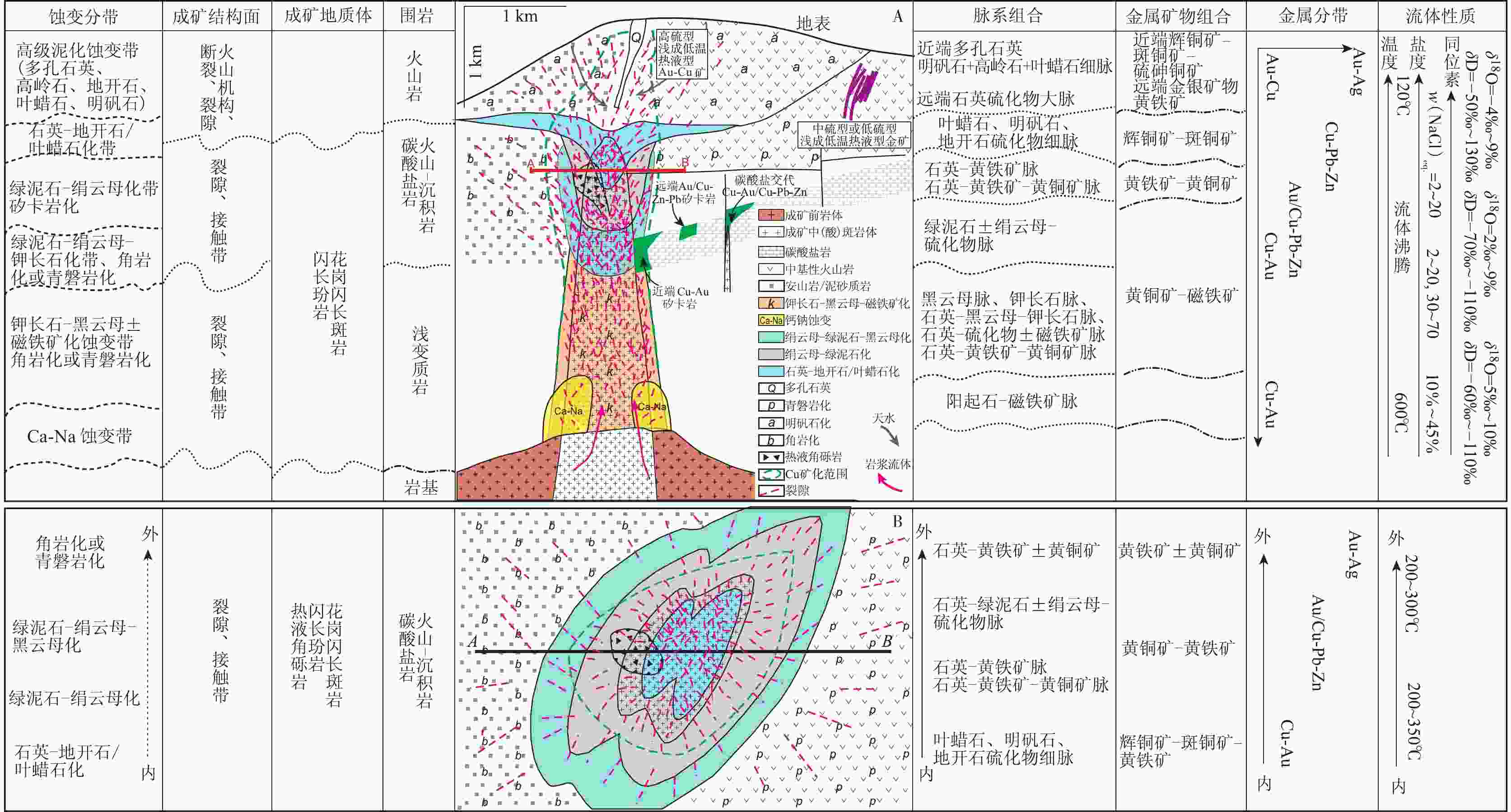
 下载:
下载:

